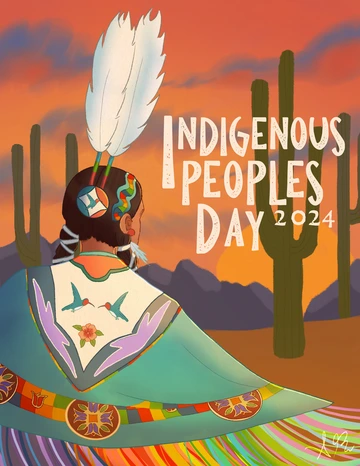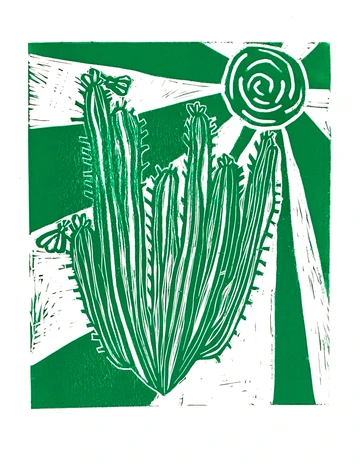Aracely Rodriguez: Art's Power to Inspire and Protect

Aracely Rodriguez is a senior studying studio art at the University of Arizona. In this Q&A, Rodriguez discusses the connections between art and environmental justice, as well as how she uses her creative expression to fight for protecting her home and community.
Could you please introduce yourself – year in school, major, and anything else you’d like to share?
My name is Aracely Rodriguez, and I am in my last semester of undergrad! I am currently working toward my BFA in Studio Art and my program is specific to illustration, design, and animation - my particular emphasis is in graphic design. I was born and raised in Arizona and am a proud daughter of immigrant parents who come from the beautiful homeland of Mexico.
How have you been involved in environmental or other activities as a student at the University of Arizona?

Aracely Rodriguez said the art she did for the 2024 UA Indigenous Peoples Day is her proudest work.
I currently work as a student employee and designer for the Indigenous Resilience Center (IRES for short!) here at the University of Arizona. Our center works to provide resources and awareness to environmental issues in tribal communities, so I have had the immense pleasure and privilege of being in community with the tribes here, as well as bringing awareness to our different events highlighting Indigenous voices in environmental work.
How do you hope to incorporate environmental or sustainability values into your future career goals?
As an artist, a key thing to keep in mind is that as we create, we are inherently also taking (inspiration, stories, resources, etc.), so it’s important to be mindful and conscious of giving back to the planet.
As someone who dabbles in mixed media, gathering materials from second-hand places or often recycling found material is very important, as well as using other untraditional materials to cut down on paper waste.
Environmental and consumer consciousness happens in the little details of an art practice - paint over an old canvas for a new project if you need it, use fabric scraps from clothes you don’t use, recycle water where you can.
I am currently taking ceramics, and we’re very conscious about recycling wastewater; we never turn on the tap unless it’s to wash our hands. All the water used in the ceramics studio is re-used to clean tools, dampen clay, etc. I also had the immense pleasure of hunting in the School of Art’s recycling bins with a classmate to find plastic for her to use in her project on water awareness!
"Art is a part of me, as cheesy as it sounds. It is what fulfills me, and what makes me feel whole and at peace ... I enjoy depicting the nature that is native to the state, as well as the emotional connection I feel to the desert."
- Aracely Rodriguez, Studio Art
Aracely Rodriguez's BFA show exhibition work, a stop-motion video based off of Pipil Nahua poet and children’s book author Jorge Argueta’s poem "Quatro Direcciones."
Are there any specific aspects of sustainability, the environment, or resilience that you are particularly passionate about?
Indigenous people are the blueprint for protecting the environment. They know the land best, and they have been implementing conservation practices for decades. Highlighting the connection people have with Earth is important for explaining why we fight so hard to take care of the planet in the first place.
While most people don’t think that the arts and environmental justice intersect, I think that having eye-catching visuals helps tell the story of why we fight for protecting our homelands. If you can communicate visually your connection with the land and with your people, it helps others understand your cause and help you advocate for it.
Water conservation is an important issue. Water is life, and it is a precious resource here in the desert. The subjects closest to my heart are issues surrounding the community and environmental resilience, and I hope to keep making more work about it.
"Highlighting the connection people have with Earth is important for explaining why we fight so hard to take care of the planet in the first place ... If you can communicate visually your connection with the land and with your people, it helps others understand your cause and help you advocate for it.
- Aracely Rodriguez, Studio Art
When you think about the intersections between art and the environment, what are some of the most significant connections to you, personally?

Recently, Rodriguez has been experimenting with printmaking, so she carved a design of a Senita Cactus with Senita moths to highlight the symbiotic relationship between plant and pollinator.
I have always spent my time in the desert. Ever since I was a child and even now, it is my favorite place to be. I enjoy depicting the nature that is native to the state, as well as the emotional connection I feel to the desert.
Cacti are perhaps a cliche example of resilience, but at its core, it is the most accurate and compelling example of surviving in hardship. Therefore, I very much enjoy photographing and including cacti imagery in my work. I hope my love for them shines through.
What draws you to studio art, and what kind of impact would you like to make through your creative expression?
Art is a part of me, as cheesy as it sounds. It is what fulfills me, and what makes me feel whole and at peace.
I have experimented throughout the past four years with different mediums and messages I want to convey in my art, and I’ve come to the realization that I want my art to serve my community.
Whether by using design to bring awareness or creating something to show the love I feel for the place I live in, I hope my artwork can show why protecting our homes and our identity is important.
Why should students care about the environment, even if it isn't their major or area of study?
We all exist on this planet together. The Earth is our home, a living entity that needs to be taken care of and preserved. It’s a simple principle of giving back when the Earth has given us so much.
We all enjoy spaces in nature, from national parks, lakes, rivers, deserts to forests. To some extent, we all enjoy some benefit from these natural resources. You cannot expect to take from the land without caring for it in return.
